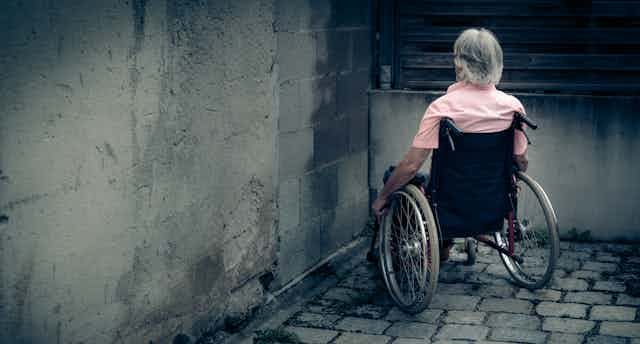Ten years ago, 38-year-old Fiona Pilkington set fire to her car with herself and her 18-year-old daughter Frankie inside. The family had experienced more than a decade of harassment and anti-social behaviour in their Leicester neighbourhood which focused on Frankie, who had learning disabilities.
Their deaths, and the inadequate response of Leicestershire Police (noted by the Independent Police Complaints Commission), became the key reference point for the disability hate crime debate, and in particular the need to increase the reporting and prosecution of crimes of this kind.
Reality behind the figures
The latest disability hate-crime figures for England and Wales reveal a significant rise of more than 50% on the year before. This could possibly be seen as positive, as it means more people are reporting these crimes.
In 2016-17 the police recorded 5,558 criminal offences “motivated by hostility or prejudice” against someone with a disability – an increase of 53% compared to 2015-16. Disability hate crimes make up around 7% of all recorded hate crimes.

The report notes that the number of offences for all hate crimes has increased since last year, attributing it to “police improving their identification and recording of hate crime offences, and more people coming forward to report these crimes rather than a genuine increase”.
In Scotland the 2016-17 figures show that there were 188 charges of “aggravation by prejudice” related to disability, a drop of 6% from the previous year and the first fall in the six years data has been collected by the Crown Office and Procurator Fiscal (COPF).
While this could be interpreted as reflecting an improvement in social attitudes towards disabled people, it is more likely, as the COPF report emphasises, that significant, continued under-reporting of incidents is the explanation.
Director of Public Prosecutions Alison Saunders emphasises in her foreword to the CPS Hate Crime Annual Report, that all types of hate crime are under-reported, but stresses “how difficult it can be for victims of disability hate crime to come forward”.
The extent of under-reporting is revealed by the Crime Survey for England and Wales (2013-14): it estimated 62,000 incidents which could potentially be defined as disability hate crimes; in the same period, 2,020 such crimes were recorded by the police.
One possible explanation is the way in which disability hate crime has become associated with exceptional acts of extreme violence. As well as the Pilkingtons, Brent Martin and David Askew both died after months of harassment, victimisation and violence.
Discrimination and exclusion
For most disabled people, acts of violence and hate do not reflect their everyday lives. What they do experience is significant discrimination and exclusion – not being able to get a space on the bus, being ignored in shops, applying for jobs and rarely getting an interview, being unable to get around town because of lack of access or facilities. There is also evidence that such negative attitudes have been fuelled by political rhetoric around welfare benefits for disabled people.
These experiences are unacceptable, but for some disabled people there is uncertainty about whether they constitute an act of hate or bigotry, and whether they should be reported to the authorities as such.

Another possible reason for the under-reporting of disability hate crime is that many disabled people know the person who harasses or abuses them, which is not a common feature of other hate crimes. Clearly when you know someone, it can be difficult to report an incident as you may be afraid of consequences.
And while the number of disability hate crime referrals from the police to the courts and conviction rate has increased (up to 79.3%) in 2016-17, the proportion of successfully completed prosecutions with an “uplift” (an increase in the sentence to reflect the hate motivation) remains relatively low, at 14.6%.
The CPS has published Support for disabled victims and witnesses of crime, a guide to encourage people to report hate crimes, and support them through the police investigation and court process. Research has also shown that staff in the criminal justice system need to do more to identify disability hate crime, support victims and ensure that sufficient evidence is gathered to bring the case to court.
In Scotland, the Lord Advocate acknowledged in 2014 that while the COPF is committed to tackling disability hate crime, the criminal justice system needs to do more.
Practical steps
There is certainly an argument to expand initiatives to support disabled people to report harassment, violence and abuse. Third party reporting centres and “Keep Safe” sites in city centres and communities can provide secure spaces for people to report. Recent statements from the CPS and COPF have focused on the determination to pursue and prosecute hate crime offenders, to boost people’s confidence in reporting these crimes.
Independent advocacy services have a key role to play, especially when the perpetrator is known to the disabled person. And improving the communication capabilities of the police with specialist training is crucial for the recording of evidence robust enough for cases to reach court.
For most disabled people it is discrimination and exclusion that dominate their lives, sometimes developing into violence and abuse. Preventative work by police, the authorities and local organisations to challenge and change negative social attitudes towards disabled people is essential. Ultimately, this is how disability hate crime will be addressed.

